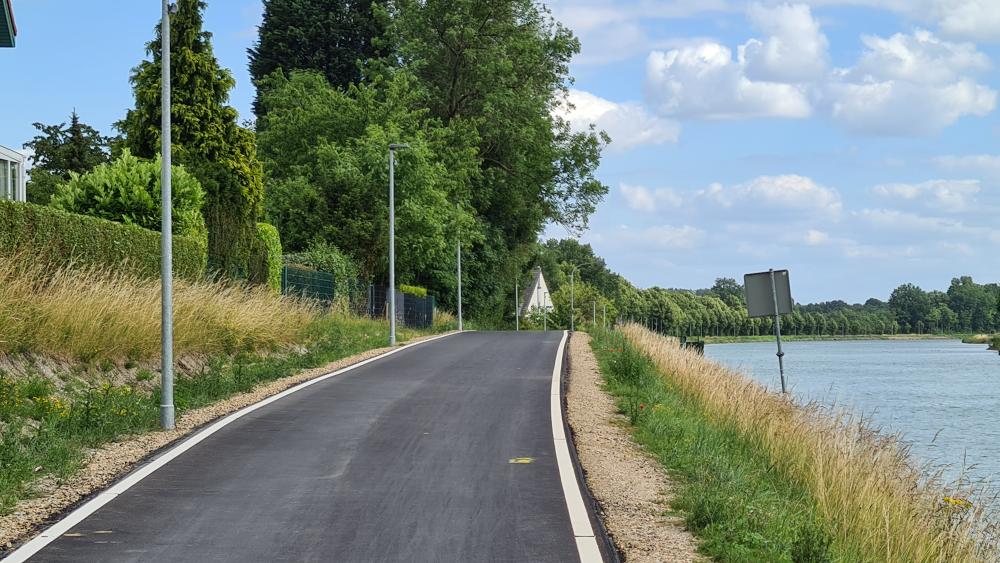
The test track in Münster next to the Dortmund-Ems Canal. | Foto: Christian Voigt / IZW
Regional cycle paths outside larger settlements are becoming increasingly important for environmentally friendly mobility. Outside the settlement area, however, cycle paths often lead through areas that have so far been unlit at night because artificial light at such locations disturbs animals in their natural habitat. Illuminating cycle paths at night would increase the safety of cyclists, but at the same time disturb protected and light-sensitive bat species. A solution that can take both needs into account would be demand-responsive lighting that only switches on when cyclists are present.
Scientists from the Leibniz Institute for Zoo and Wildlife Research (Leibniz-IZW) and the Leibniz Institute of Freshwater Ecology and Inland Fisheries (IGB) have now investigated such a concept in a pilot project in the Münster urban region. For their investigations, they took a close look at part of a newly constructed, 27-kilometre-long cycle route with on-demand lighting. Using synchronised thermal imaging cameras, they reconstructed movement paths of bats in the vicinity of street lamps and measured the exact luminance, illumination distribution and spectral distribution of the light from the lamps. In addition, they recorded bat activity in relation to demand-based light management using automatic acoustic detectors. "In this way, we can reliably identify which bats show which behaviour depending on the lighting situation," says PD Dr Christian Voigt, head of the Evolutionary Ecology Department and project leader at Leibniz-IZW.
It became clear that bats avoided the vicinity of the cycle path during those times when the lanterns were actually switched on. Bats of different functional groups, so-called feeding guilds, differed in their activity pattern and thus also in their reaction. Bats that hunt for insects particularly frequently at forest edges tolerated the artificial light in the evening and morning hours, but avoided the lamps in the middle of the night; even though the lamps were rarely switched on then. The locally rarer group of open space hunters and forest specialists, on the other hand, only showed pronounced avoidance behaviour towards artificial light in the later hours of the night.
The statistical evaluations show that demand-responsive light management can reduce disturbances for bats, the team concluded. The lanterns were on between 5 and 70 per cent of the time, depending on the intensity of use by cyclists. "This is a clear gain, especially for the forest specialists, who are consistently active throughout the night," says Voigt. "At the same time, it's clear that this is only a partial win for the bats, as lanterns were lit nearly three-quarters of the time during important marginal times of the night." Possibly this could be further reduced by shorter lighting interval times, the team said. Avoiding artificial light - i.e. only lighting where there is actually an urgent need - is still considered the first priority when planning lighting inside and outside settlements, they said.
About the FLEBEFA project
Bats react sensitively to artificial lighting. This has been proven many times, especially in cities. Bats are strictly protected according to national, EU law and worldwide agreements, for example by §7 of the Federal Nature Conservation Act, by the EU Fauna-Flora-Habitat Directive 92/43/EEC and the United Nations Convention on the Protection of Migratory Species. There is therefore a duty to protect bat habitats and ensure positive population development. In the project "Development of a bat-friendly adaptive lighting concept for cycle paths" (FLEBEFA), which started in May 2022, research was conducted into the influence of artificial lighting on protected bats by establishing a demand-based lighting management system along a regional cycle path on the Dortmund-Ems Canal. The model project of bat-friendly adaptive lighting should make it possible to establish similar lighting management at other locations.
About the BMDV's mFUND funding programme
As part of the mFUND innovation initiative, the BMDV has been funding data-based research and development projects for the digital and connected mobility of the future since 2016. Project funding is supplemented by active professional networking between stakeholders from politics, business, administration and research. Open data is made available via the Mobilithek. Further information can be found at www.mFUND.de.






